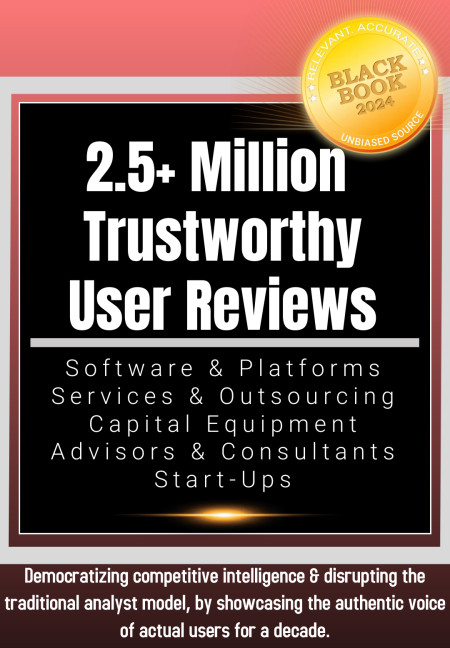Black Book IT Leader Survey Reveals 8 Technologies Draining Value From Health Systems

CHICAGO, October 1, 2024 (Newswire.com) - A new survey from Black Book Research highlights multiple healthcare IT implementations that have failed to meet expectations, with industry technology professionals pointing to issues like poor user experience, lack of interoperability, and high costs. In the third part of Black Book’s “What’s Hot and What’s Not in Healthcare IT Investments,” 907 healthcare professionals shared their insights on which systems have not delivered the return on investment (ROI) expected after deployment.
Every participant in the survey reported having worked in a hospital, physician practice or payer organization where an IT software or outsourcing engagement resulted in financial loss, significant workflow interruptions, reputational damage, or loss of key staff sometime in the past decade.
A 2017 report by Black Book Market Research estimated that U.S. hospitals lost around $1.7 billion annually due to outdated or poorly performing IT systems. In 2024, respondents indicated that the compounding inefficiencies, system downtimes, and ineffective integration of health IT have led to total losses estimated to exceed $8.0 billion annually across the industry. The costs include reduced operational efficiency, data breaches, delayed patient care, and administrative burdens. In some cases, hospitals may lose millions individually due to these issues, especially when productivity and revenue cycle disruptions are factored in.
"Three-quarters of IT leaders surveyed indicated that they have no plans to allocate funds for replacing these flawed systems in 2025, reflecting a broader trend of financial constraints across the sector," said Doug Brown, President of Black Book. Additionally, 60% of respondents expressed concern they will likely lack the capital needed to address these critical system issues even through 2027, underscoring the long-term financial challenges that may delay much-needed improvements in healthcare IT infrastructure.
Brown emphasized that despite the undeniable value healthcare IT systems can bring, the survey underscores significant areas of concern, particularly in usability, integration, and cost. These challenges have not only slowed the adoption of new technologies like AI but, in some cases, prompted providers to explore alternative solutions or even revert to manual processes in an attempt to regain efficiency.
"CIOs are understandably cautious about replacing underperforming systems when the ROI is uncertain, given the track record of many healthcare IT vendors failing to meet expectations," said Brown. "Without clear evidence that a new investment will deliver tangible financial or operational improvements, justifying the expense becomes challenging."
Black Book's research study aims to equip IT buyers with the critical insights needed to ask the right questions, helping them navigate the often opaque or misleading information typically found in many commissioned vendor evaluations.
The primary IT systems that have drained the most value from hospitals and healthcare providers include:
1. Overly Complex or Unintuitive EHR Systems
Electronic Health Record (EHR) systems were a significant point of criticism by IT staffers. Among the major EHR systems surveyed respondents have worked with:
- 77% of users reported ongoing user experience issues, such as cumbersome workflows, poor customization, and difficult navigation. These problems contribute to "click fatigue," leading to inefficiencies and more time-consuming daily tasks.
- 91% of small medical practices criticized major hospital system EHRs they were compelled or required to engage with as being overly complex and difficult to implement and maintain without adequate IT support, particularly for independent physician settings.
2. Poorly Integrated Telehealth Platforms
The rush to adopt telehealth during the COVID-19 pandemic revealed ongoing flaws in many of the leading platforms:
- 81% of respondents reported that some telehealth solutions failed to integrate well with existing EHR systems, creating data silos, duplicating data entry, and resulting in workflow inefficiencies.
3. Revenue Cycle Management (RCM) Systems with Poor Automation
Revenue cycle management systems have also faced challenges in delivering value:
- 70% of respondents gave negative feedback on their RCM software vendor or outsourcing partners, describing them as outdated and lacking advanced automation features such as functioning AI. This led to longer processing times for claims and higher denial rates according to 79% of their clientele.
- 61% of providers expressed frustration over poor claims scrubbing and denial management capabilities, which led to lost revenue.
4. Health Information Exchanges (HIEs) with Limited Interoperability
Health Information Exchange (HIE) platforms are another area where systems have fallen short:
- 23% of physician practices said their early-stage HIE platforms still struggle with data standardization and integration, limiting their ability to leverage shared patient information.
- 28% of medical practices reported ongoing issues due to EHR interoperability shortcomings, further hampering their ability to access complete patient records and coordinate care.
5. Clinical Decision Support (CDS) Systems with Poor Integration
Clinical Decision Support (CDS) tools have also been problematic for many:
- 80% of users cited a lack of proper integration with EHRs, which severely undermined the value of CDS systems. First-generation CDS tools often generated excessive or irrelevant alerts, contributing to "alert fatigue" among clinicians.
- 93% of respondents with outdated or static CDS tools said they lacked real-time, evidence-based guidance, rendering them ineffective in driving clinical decisions.
6. Patient-Engagement Platforms with Low Adoption
Patient-engagement tools, especially early versions of patient portals, struggled with adoption:
- 77% of reporting hospital systems with implemented patient portals had poor user interfaces and limited functionality, making them difficult for patients to navigate and reducing their effectiveness in fostering communication and engagement.
- Smaller vendors offering niche patient engagement solutions also failed to gain traction in 88% of providers, often due to poor EHR integration and a lack of mobile-friendly features.
7. AI and Machine Learning Tools with Unrealized Promises
Despite high expectations and funding hype for artificial intelligence and machine learning in healthcare, most AI systems have underdelivered so far say health systems:
- 96% of healthcare IT executives said they faced challenges with AI ROI, with 92% of early adopters reported that their current AI systems were not accurate or actionable enough in clinical settings.
- 85% of early adopters aimed at automating diagnostics or treatment planning saw little to no ROI, as these AI systems failed to grasp the complexities of real-world clinical environments.
8. Interoperability Solutions with Limited Support
Interoperability remains an ongoing, critical issue for many healthcare providers:
- 31% of providers expressed dissatisfaction with their data interoperability vendors, citing poor API support and slow updates. Many smaller platforms struggled to keep pace with evolving standards like FHIR (Fast Healthcare Interoperability Resources), leaving 8% of current providers with outdated, non-interoperable systems.
Key Reasons for Failure to Deliver Value
When asked to identify the one top reason for the failure of healthcare IT systems, professionals ranked the following:
- Poor User Experience: 48% of respondents cited user-unfriendly systems that increased provider burnout and inefficiency.
- Lack of Interoperability: 24% mentioned systems that don't integrate well with other platforms, leading to data silos.
- High Costs: 20% noted that expensive systems without sufficient ROI are placing financial strain on providers.
- Lack of Flexibility: 6% pointed to inflexible software that couldn’t adapt to specific workflows or needs.
- Alert Fatigue: 2% cited excessive or irrelevant alerts from CDS systems, which devalued the software.
"As healthcare IT continues to evolve, addressing these issues will be critical," said Brown. "Improving the user experience, ensuring seamless integration between systems, and managing the escalating costs are all essential steps for the industry to realize the full potential of these technologies." Without resolving these pain points, hospitals may struggle to achieve the operational efficiency and enhanced patient outcomes that well-functioning IT systems can offer. "Ultimately, the future success of healthcare IT hinges on its ability to provide real, sustainable value without imposing additional burdens on providers."
About Black Book
Black Book™, its founder, management, and staff do not own or hold any financial interest in any of the vendors covered and encompassed in the vendor satisfaction surveys it conducts. Since 2011, Black Book has reported the results of the collected satisfaction and client experience rankings in publication and to media prior to vendor notification of rating results and does not solicit vendor participation fees, review fees, inclusion or briefing charges, consultation requirements, and/or vendor collaboration as Black Book directly polls vendors' clients. More information is available at https://blackbookmarketresearch.com.
Source: Black Book Research
